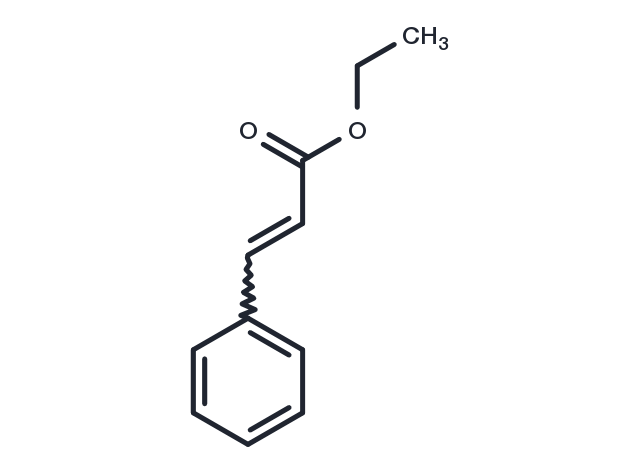Powder: -20°C for 3 years | In solvent: -80°C for 1 year


Ethyl cinnamate has antifungal, and vasorelaxant effects. Ethyl cinnamate can lead to the damage of cell membrane system and metabolic disorder through inducing lipid peroxidation via initiating ROS overproduction. Ethyl cinnamate can inhibit the tonic contractions induced by high K+ and phenylephrine (PE) in a concentration-dependent manner, with respective IC50 values of 0.30 mM and 0.38 mM.

| Pack Size | Availability | Price/USD | Quantity |
|---|---|---|---|
| 1 g | In stock | $ 30.00 | |
| 1 mL * 10 mM (in DMSO) | In stock | $ 29.00 |

| Description | Ethyl cinnamate has antifungal, and vasorelaxant effects. Ethyl cinnamate can lead to the damage of cell membrane system and metabolic disorder through inducing lipid peroxidation via initiating ROS overproduction. Ethyl cinnamate can inhibit the tonic contractions induced by high K+ and phenylephrine (PE) in a concentration-dependent manner, with respective IC50 values of 0.30 mM and 0.38 mM. |
| Targets&IC50 | Tonic contractions (chenylephrine-induced):0.38 mM, Tonic contractions (high K+-induced):0.30 mM |
| In vitro | Parameters, including biomass, F(v)/F(m) (maximal photochemical efficiency of PSII), Ф(PSII) (actual photochemical efficiency of PSII in the light), FDA, and PI staining fluorescence, were measured. The results showed the following: (1) The inhibition on biomass increased as the exposure concentration increased. 1 mg/L Ethyl cinnamate was sufficient to reduce the total biomass of C. vulgaris. The 48-h and 72-h EC50 values were 2.07 mg/L (1.94-2.20) and 1.89 mg/L (1.82-1.97). (2) After 24 h of exposure to 2-4 mg/L Ethyl cinnamate, the photosynthesis of C. vulgaris almost ceased, manifesting in DФ(PSII) being close to zero. After 72 h of exposure to 4 mg/L Ethyl cinnamate, the Fv /Fm of C. vulgaris dropped to zero. (3) Ethyl cinnamate also affected the cellular physiology of C. vulgaris, but these effects resulted in the inhibition of cell yield rather than cell death[1] |
| Source |
| Molecular Weight | 176.21 |
| Formula | C11H12O2 |
| CAS No. | 103-36-6 |
Powder: -20°C for 3 years | In solvent: -80°C for 1 year
DMSO: 50 mg/mL (283.75 mM), Sonification is recommended
You can also refer to dose conversion for different animals. More
bottom
Please see Inhibitor Handling Instructions for more frequently ask questions. Topics include: how to prepare stock solutions, how to store products, and cautions on cell-based assays & animal experiments, etc.
Ethyl cinnamate 103-36-6 Immunology/Inflammation Membrane transporter/Ion channel Metabolism Calcium Channel NO Synthase ROS Inhibitor fragrance inhibit clearing reagent inhibitor
